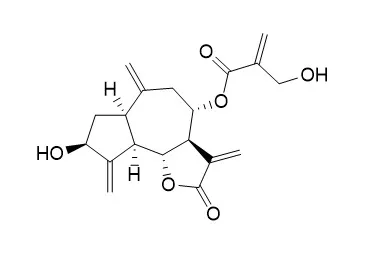| Kinase Assay: |
| Toxicol Lett. 2015 Apr 16;234(2):74-80. | | Cynaropicrin attenuates UVB-induced oxidative stress via the AhR-Nrf2-Nqo1 pathway.[Pubmed: 25680693] | Due to its antioxidant and anti-inflammatory activities, artichoke (Cynara scolymus) has been used as folk medicine to treat various diseases. Cynaropicrin (Cyn), a sesquiterpene lactone, is the major bioactive phytochemical in the artichoke; however, its pharmacological mechanism remains unknown.
METHODS AND RESULTS:
Because some phytochemicals exert their antioxidant activity by activating aryl hydrocarbon receptor (AhR), leading to subsequent induction of the antioxidant pathway including nuclear factor E2-related factor 2 (Nrf2) and NAD(P)H: quinone oxidoreductase 1 (Nqo1), we investigated whether Cyn also activates the AhR-Nrf2-Nqo1 pathway. Cyn indeed induced the activation (nuclear translocation) of AhR, leading to nuclear translocation of Nrf2 and dose-dependent upregulation of Nrf2 and Nqo1 mRNAs in human keratinocytes. The Cyn-induced AhR-Nrf2-Nqo1 activation was AhR- and Nrf2-dependent, as demonstrated by the observation that it was absent in keratinocytes transfected by siRNA against either AhR or Nrf2. In accordance with these findings, Cyn actively inhibited generation of reactive oxygen species from keratinocytes irradiated with ultraviolet B (UVB) in a Nrf2-dependent manner. Cyn also inhibited the production of proinflammatory cytokines such as interleukin 6 and tumor necrosis factor-α from UVB-treated keratinocytes.
CONCLUSIONS:
Our findings demonstrate that Cyn is a potent activator of the AhR-Nrf2-Nqo1 pathway, and could therefore be applied to prevention of UVB-induced photo aging. |
|
| Cell Research: |
| Eur J Pharmacol. 2004 May 25;492(2-3):85-94. | | Cytotoxic and pro-apoptotic activities of cynaropicrin, a sesquiterpene lactone, on the viability of leukocyte cancer cell lines.[Pubmed: 15178350 ] | Cynaropicrin, a sesquiterpene lactone from Saussurea lappa, has been reported to possess immunomodulatory effects on cytokine release, nitric oxide production and immunosuppressive effects. In this study, we have examined cytotoxic effect of Cynaropicrin against several types of cell lines such as macrophages, eosinophils, fibroblasts and lymphocytes.
METHODS AND RESULTS:
Cynaropicrin potently inhibited the proliferation of leukocyte cancer cell lines, such as U937, Eol-1 and Jurkat T cells, but some other cells such as Chang liver cells and human fibroblast cell lines were not strongly suppressed by Cynaropicrin treatment. The cytotoxic effect of Cynaropicrin was due to inducing apoptosis and cell cycle arrest at G1/S phase, according to flow-cytometric, DNA fragmentation and morphological analyses using U937 cells. Evidence that combination treatment with l-cysteine and N-acetyl-l-cysteine, reactive oxygen species scavengers, or rottlerin (1-[6-[(3-acetyl-2,4,6-trihydroxy-5-methylphenyl)methyl]-5,7-dihydroxy-2, 2-dimethyl-2H-1-benzopyran-8-yl]-3-phenyl-2-propen-1-one), a specific protein kinase (PK) Cdelta inhibitor, abolished Cynaropicrin-mediated cytotoxicity and morphological change, and that Cynaropicrin-induced proteolytic cleavage of PKCdelta suggests that reactive oxygen species and PKCdelta may play an important role in mediating pro-apoptotic activity by Cynaropicrin.
CONCLUSIONS:
Taken together, these results indicate that Cynaropicrin may be a potential anticancer agent against some leukocyte cancer cells such as lymphoma or leukemia, through pro-apoptotic activity. |
|






 Cell. 2018 Jan 11;172(1-2):249-261.e12. doi: 10.1016/j.cell.2017.12.019.IF=36.216(2019)
Cell. 2018 Jan 11;172(1-2):249-261.e12. doi: 10.1016/j.cell.2017.12.019.IF=36.216(2019) Cell Metab. 2020 Mar 3;31(3):534-548.e5. doi: 10.1016/j.cmet.2020.01.002.IF=22.415(2019)
Cell Metab. 2020 Mar 3;31(3):534-548.e5. doi: 10.1016/j.cmet.2020.01.002.IF=22.415(2019) Mol Cell. 2017 Nov 16;68(4):673-685.e6. doi: 10.1016/j.molcel.2017.10.022.IF=14.548(2019)
Mol Cell. 2017 Nov 16;68(4):673-685.e6. doi: 10.1016/j.molcel.2017.10.022.IF=14.548(2019)